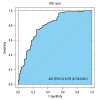A Risk Prediction Model for Prolonged Length of Stay in Patients with Acute Exacerbations of Chronic Obstructive Pulmonary Disease: A Retrospective Study of 225 Patients in a Single Center in Kunming, China
- PMID: 35136009
- PMCID: PMC8842644
- DOI: 10.12659/MSM.934392
A Risk Prediction Model for Prolonged Length of Stay in Patients with Acute Exacerbations of Chronic Obstructive Pulmonary Disease: A Retrospective Study of 225 Patients in a Single Center in Kunming, China
Abstract
BACKGROUND We aimed to develop an effective prediction model of prolonged length of stay (LOS) in patients with acute exacerbations of chronic obstructive pulmonary disease (AECOPD). MATERIAL AND METHODS We systematically enrolled 225 patients admitted for AECOPD to our hospital and divided them into a normal LOS group (≤7 days) and prolonged LOS group (>7 days). To analyze differences in laboratory data at different times, 3 logistic regression models were established. To develop the prediction model, all variables with statistical significance were included in the model. The area under the curve (AUC) was used to evaluate discrimination, and the Hosmer-Lemeshow test was used to assess the calibration of the model. RESULTS Factors found to be independently associated with the increased risk of prolonged LOS included the use of corticosteroids during hospitalization, elevated HCO₃⁻, decreased pH, and reductions in platelets (PLTs) and procalcitonin (PCT) between the fourth and first day of hospitalization. The risk prediction model including these factors had an AUC of 0.795, suggesting the good discrimination of our model. The Hosmer-Lemeshow test also showed good calibration of the model, which confirmed its good predictive performance. CONCLUSIONS A clinical prediction model was developed with good predictive performance, which could help clinicians identify patients with a higher risk of prolonged LOS, help shorten hospital stay, reduce the disease burden of patients, and improve the outcomes of AECOPD.
Conflict of interest statement
Figures
Similar articles
-
Factors associated with a prolonged length of stay after acute exacerbation of chronic obstructive pulmonary disease (AECOPD).Int J Chron Obstruct Pulmon Dis. 2014 Jan 20;9:99-105. doi: 10.2147/COPD.S51467. eCollection 2014. Int J Chron Obstruct Pulmon Dis. 2014. PMID: 24477272 Free PMC article.
-
Impact of Procalcitonin Guidance on Management of Adults Hospitalized with Chronic Obstructive Pulmonary Disease Exacerbations.J Gen Intern Med. 2018 May;33(5):692-697. doi: 10.1007/s11606-018-4312-2. Epub 2018 Feb 5. J Gen Intern Med. 2018. PMID: 29404940 Free PMC article.
-
Retrospective audit of antimicrobial prescribing practices for acute exacerbations of chronic obstructive pulmonary diseases in a large regional hospital.J Clin Pharm Ther. 2017 Jun;42(3):301-305. doi: 10.1111/jcpt.12514. Epub 2017 Mar 1. J Clin Pharm Ther. 2017. PMID: 28251670
-
Construction and validation of risk prediction model for deep vein thrombosis in acute exacerbations of chronic obstructive pulmonary disease based on serum angiopoietin 2 levels.Ann Palliat Med. 2021 Jul;10(7):7905-7918. doi: 10.21037/apm-21-1448. Ann Palliat Med. 2021. PMID: 34353078
-
Procalcitonin and other markers to guide antibiotic use in chronic obstructive pulmonary disease exacerbations in the era of antimicrobial resistance.Curr Opin Pulm Med. 2019 Mar;25(2):158-164. doi: 10.1097/MCP.0000000000000555. Curr Opin Pulm Med. 2019. PMID: 30550505 Review.
Cited by
-
Prognostic risk prediction model for patients with acute exacerbation of chronic obstructive pulmonary disease (AECOPD): a systematic review and meta-analysis.Respir Res. 2024 Nov 14;25(1):410. doi: 10.1186/s12931-024-03033-4. Respir Res. 2024. PMID: 39543648 Free PMC article.
-
A risk nomogram for predicting prolonged intensive care unit stays in patients with chronic obstructive pulmonary disease.Front Med (Lausanne). 2023 Jul 6;10:1177786. doi: 10.3389/fmed.2023.1177786. eCollection 2023. Front Med (Lausanne). 2023. PMID: 37484842 Free PMC article.
References
-
- Labaki WW, Rosenberg SR. Chronic obstructive pulmonary disease. Ann Intern Med. 2020;173:ITC17–32. - PubMed
-
- Barnes PJ, Burney PG, Silverman EK, et al. Chronic obstructive pulmonary disease. Nat Rev Dis Primers. 2015;1:15076. - PubMed
-
- Rabe KF, Watz H. Chronic obstructive pulmonary disease. Lancet. 2017;389:1931–40. - PubMed
MeSH terms
Substances
LinkOut - more resources
Full Text Sources
Medical



